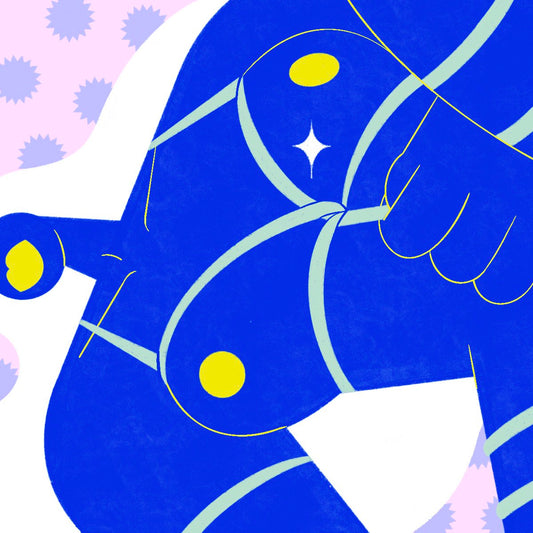Alexandra Fine, Credentialed Sexologist, M. Psych | Written by Dame
Why Humans Daydream and Fantasize | Common Sexual Fantasies | What Do Sexual Fantasies Mean? | Do Fantasies Vary by a Person’s Gender Identity? | Are They Good For You And Your Sex Life?
Do you daydream?
Of course you do. Psychology Today reports that as many as 96% of adults report daydreaming at least once per day.
Even more startling, Harvard psychologists have found that fantasizing is much more than just an occasional thing; their study discovered that peoples’ minds wander for nearly 50% of the time they’re awake. The only time when daydreaming and fantasizing was significantly reduced? During sex.
Several topics are extremely common. A survey conducted by OnePoll found that Americans spend, on average, 200 waking hours per year dreaming about going on vacation. Many others daydream about the future or what they could have done differently in their past. Some fantasize about having superpowers or fantastical adventures.
But more than anything else, and regardless of age, gender identity, sexual orientation or relationship status, people fantasize about sex.
Noted social psychologist Justin Lehmiller, PhD, a researcher at the famed Kinsey Institute, has surveyed thousands of Americans. And even though his math may not quite jibe with the earlier statistics we’ve cited, he says his research shows that 97% of participants reported having sexual fantasies.
In fact, 97% is a big enough number to let us conclude that just about everyone fantasizes about sex.
Why does it happen? And what do most people fantasize about?
Good questions. Let’s find some good answers.
Why Humans Daydream and Fantasize
The layman’s answer to the question “why do we daydream?” would most likely be “because we’re bored.”
Experts have researched that question for more than a century beginning with Germany’s Wilhelm Mundt, known as one of the founders of modern and experimental psychology. And neuroscientists are still researching the subject today.
The most prevalent view concerns sensory structures in the brain, linked together in what’s called the brain’s default network. This network appears to have two functions. First, it supports regular brain functions like memory when people are actively engaged in normal activities.
However, when people are passive – that is, not engaged in specific goal-directed tasks – the default network seems to become more active and creates its own stimulation. Scientists call it “stimulus independent thought.” What we’d be more likely to call that stimulation, though, is daydreaming and fantasizing.
Prominent psychologists like Randy Buckner believe the default network exists to help people remember and explore past experiences. Researchers have also theorized for decades that daydreaming is one of the primary creative stimuli provided by the brain and its default network; its purpose may be facilitating exploration and discovering new solutions to existing problems.
That’s all fascinating stuff. It doesn’t fully explain, however, why nearly all of us have sexual fantasies and daydreams. Let’s dig a little deeper.
Common Sexual Fantasies
If we combine the theory that fantasy and daydreams exist to explore our thoughts and past experiences, with the physical and emotional needs also being processed by the brain, it might be possible to explain why some sexual fantasies are so common.
In fact, the social psychologist we mentioned earlier, Justin Lehmiller, has used his extensive research findings to do just that.
Before we get into explanations, though, let’s learn about the most common sexual fantasies – with one qualifier: dreams about sex during sleep aren’t included, since the dreamer has no control over them. Lehmiller describes sexual fantasies as arousing mental pictures that are experienced while awake.
Data is only as good as the people who collect it and the methodology they use, of course. Since studies summarizing people’s fantasies rely on input from survey participants, and this is a subject of great interest to sex therapists and researchers, there have been a number of different studies and each has drawn their own conclusions.
We’ll focus on two of those studies.
Tell Me What You Want
We’re starting with Lehmiller, who detailed his findings in his book Tell Me What You Want. He surveyed more than four-thousand Americans of all ages, gender and sexual identities, relationship types, religions, occupations and socio-economic backgrounds. And he says their shared sexual fantasies were remarkably similar.
1. Group Sex
It wasn’t even close. One-third of all participants regularly fantasized about group sex, and very few said they never daydreamed about it at all.
“Threesomes” was the most common group sex fantasy, but the specifics varied in ways that might be surprising – and we’ll use Lehmiller’s terminology to explain. “Heterosexual men” were likely to visualize themselves with two women, for example, but “straight women’s” imagined sexual partners were also two vulva-havers. Orgies and gangbangs were also mentioned, but not as often.
2. BDSM
More than 25% of respondents had regular fantasies involving different flavors. Bondage, discipline, submission, dominance, sadism and masochism were all repeatedly mentioned. There were specific sexual acts mentioned, naturally; they included role-playing involving power games, receiving (or giving) pain, spanking, restraints and other BDSM implements.
3. Variety
This category also includes scenarios involving adventure and novelty. Among the fantasies commonly mentioned were sex in new and different positions, sex in public places, exhibitionism, and – believe it or not – sexual acts that included food.
A number of respondents to Lehmiller’s surveys regularly fantasized about other types of sexual activity. In order of frequency, they are:
- Taboo sex acts, including everything from voyeurism and exhibitionism (somewhat common) to non-consensual sex and pedophilia (much less common)
- Passion, romance and intimacy (interestingly, this was the most common fantasy that respondents reported; they just didn’t have it as often as the ones higher on the list)
- Non-monogamy, including swinging, open relationships, polyamory and cuckolding
- Gender-bending and homoeroticism
University of Quebec Study
Another illuminating study on the same subject was conducted in Canada and published in the Journal of Sexual Medicine.
The (at the time) recent release of the book and movie series Fifth Shades of Grey may have had an effect on the results. Those who had at least one submissive fantasy were likely to score higher on sexual fantasizing scales in general; by contrast, a study published in the Journal of Sex Research indicated that penis-havers were more likely to fantasize about dominance than submission.
The most-common sex fantasies for vulva-havers, according to the Journal of Sexual Medicine survey:
- Sex in a romantic location
- Sex in an unusual place
- Taking part in oral sex
- Performing oral sex on a male (sic)
- Being masturbated by a partner
- Performing masturbation on a partner
- Sex with a non-spouse acquaintance
- Being dominated sexually
- Sex in a public place
- Sex with more than three people, both men and women
Several more fantasies weren’t as common for vulva-havers, but those who had them said they were particularly intense: having sex with two women, watching two women have sex and having sex with a stranger.
The ten most-common fantasies for penis-havers were quite different in this survey.
- Giving/receiving oral sex
- Having sex with two women
- Having sex with a non-partner
- Having sex in an unusual place
- Watching two women have sex
- Ejaculating on a sexual partner
- Having sex in a romantic location
- Performing oral sex on a woman
- Masturbating a partner
- Having sex with more than three women
One fact from this survey, which might be construed as good news: Taboo fantasies that are illegal (bestiality, pedophilia) finished at the very bottom of the list.
What Do Sexual Fantasies Mean?
It may be reassuring to know that many other people have the same fantasies that you do. However, those erotic thoughts can still be disturbing – leaving you to wonder exactly what they mean.
It could take hours and hours of psychotherapy for a trained professional to determine the reasons why their patient has a specific fantasy. Lehmiller, however, has some general answers about the most-common fantasies he discovered in his research. And he says they’re often linked to deep psychological needs.
- Group Sex: Lehmiller says these fantasies frequently stem from a desire to be sexually irresistible and sexually competent. That’s why, in most group sex fantasies, the daydreamer is likely to be the center of attention. Fantasizing about several people who want to have sex with you makes you feel desired and attractive, and it makes you feel better about your sexual abilities when you imagine satisfying more than one person at the same time.
- Romance and Passion: Responses to Lehmiller’s questioning indicate that the fantasizer has needs to connect emotionally with a partner and to feel loved. Daydreaming about the “perfect” sexual experience, in the “perfect” situation, with the “perfect” partner, provides the feelings of intimacy and love that they crave, while easing any insecurity they may feel in real life.
- BDSM: This one isn’t surprising, either. Lehmiller says that those who fantasize about submissive or masochistic behaviors, in particular, have a need to be desired and a need to seek approval. They may also enjoy these daydreams because in fantasies, they’re under no pressure to perform sexually.
What’s perhaps more interesting is that he believes BDSM fantasies, in general, indicate a desire to temporarily forget about day-to-day anxieties, insecurities and problems by focusing attention solely on the details (and often, pain) of the sexual encounter. In other words, fantasizing about BDSM play is actually a form of mindfulness.
Lehmiller says there are two common categories of sexual daydreamers whose fantasies indicate that they want to try new things or get out of a sexual rut.
One group is comprised of people who have taboo fantasies; he says that can mean the dreamer is creative and wants to try new and different sexual activities. The second category is people who are in their 40s or 50s and in long-term relationships; Lehmiller says they’re likely to have sexual fantasies more often than younger people because they desire novelty.Their daydreams allow them to “break free,” even if only temporarily and only in their fantasies.
Other experts theorize that specific sexual fantasies allow people to plan their future sexual behavior, experience emotional security, improve confidence in the bedroom, or briefly escape an unsatisfying sex life or sexual relationship.
Do Fantasies Vary by a Person’s Gender Identity?
Apparently they often do, according to studies that date back to the days of sex researchers Masters and Johnson. They reported in 1979 that “homosexual men” most commonly fantasized about penises and buttocks, forced sexual experiences, and group sex. Interestingly, though, Masters and Johnson’s research showed that straight and gay penis-havers had similar fantasies – simply involving different genders.
A 2005 study compared the sexual fantasies of vulva-havers based on their “sexual orientation.” It found that gay and straight women’s fantasies were quite similar, often focusing on specific body parts of imagined partners. The only major difference was that the former daydreamed about vulva owners’ body parts, while the latter fantasized about penis-havers’ bodies.
That may be understandable. Italian researchers found that even though lesbian participants reported fewer romantic/emotional fantasies than straight women, it appears that gender roles and sexual fantasies are controlled by different mechanisms, and are relatively independent from one another.
Are Sexual Fantasies Good For You And Your Sex Life?
Virtually everyone has sexual fantasies, but a substantial number of people feel guilt or shame about them.
Should they? Most psychologists and researchers say no.
There have been studies, for example, showing that fantasies about extramarital or multiple partner experiences have a positive correlation with successful long-term relationships. In other words, the daydreamers apparently use their fantasies as a way to deal with any sexual unhappiness they may be feeling. Other research has shown that there is a positive correlation between regularly having sexual fantasies, and a person’s sexual desire and arousal, orgasm and contentment. In short, those who fantasize have better sex lives.
Freud once said that “a happy person never fantasizes, only a dissatisfied one.” That became known as the deficiency syndrome and a number of his followers believed it – for a while.
We now know differently. Sexual fantasies are not only common, they’re essentially universal. And an important review of the literature, performed by Harold Leitenberg and Kris Henning, concluded that sexual fantasy is closely associated with sexual arousal, sexual satisfaction and better odds of meaningful sexual relations.
Bottom line: there’s nothing to be guilty about or ashamed of. Sexual fantasies are simply one indication of sexual health and wellness.



























